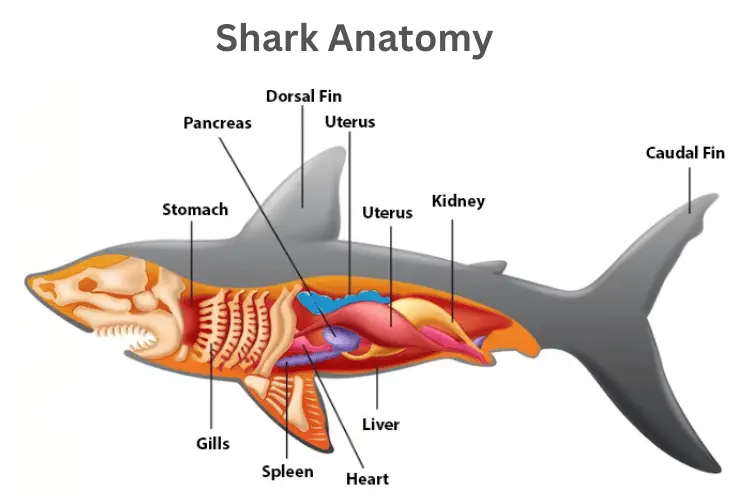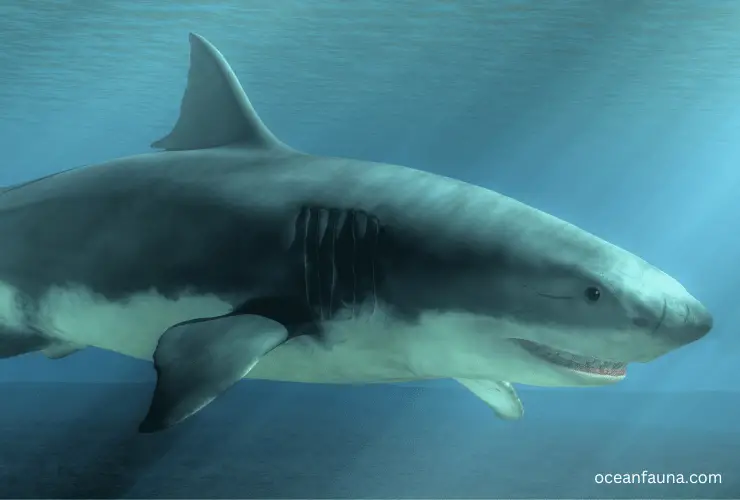Sharks’ breathing system is almost similar to fish. They breathe constantly using their gills. So, how do sharks breathe with gills?
Don’t worry. I will discuss everything in detail in this article.
Do Sharks Have Gills or Lungs?
Sharks are from the fish family. So, they have gills instead of lungs like mammals.
Gills are specialized organs aquatic animals (except marine mammals) use to breathe or get oxygen from their water. Behind their mouths and just in front of their pectoral fins, sharks have 5 to 7-gill slits on each side. These gills open up a network of structures inside the fish that pull oxygen from the water as it swims through them.

The operation of these gills is very efficient since they can extract larger amounts of oxygen than what can be obtained through the mammals’ lungs alone.
Additionally, sharks possess an additional form of respiration called buccal pumping which helps supplement their oxygen needs. This involves opening and closing the shark’s mouth so as to create a vacuum suction that pulls in more oxygen-rich water for respiration.
Thus, sharks have adapted to thrive in aquatic environments by possessing gills and buccal pumping for efficient underwater breathing.
Where Are Sharks’ Gills Located?
Nestled between the pectoral fins and just behind their mouths, Sharks boast gills on either side of their heads. Most species have five slits per side, and others have seven. These slits provide oxygen to the shark by allowing water to pass over its gill filaments and into its body. This process allows for oxygen to be collected from the water, allowing sharks to stay underwater for extended periods.
The gills also act as a filter, catching and trapping particles that can be consumed later. Sharks with more gill slits typically have higher concentrations of certain types of blood cells, which can help them survive deeper and darker environments where food is scarce.
Additionally, these extra slits aid with thermoregulation as they allow more water to flow over the skin, helping the shark keep its core temperature at an optimum level by absorbing or releasing heat.
How Do Sharks Breathe Using Their Gills?
Sharks use their gills to take in oxygen from the water they swim in. This process is called ram ventilation because the shark must constantly move and swim to push the water over its gills, known as buccal pumping. It allows them to extract oxygen from it and also breathe out carbon dioxide.
The water is taken in through the shark’s mouth and then passes over the gill filaments, which are thin sheets lined with tiny blood vessels that help absorb dissolved oxygen from the water.

Once oxygen is absorbed into the cells of these blood vessels, carbon dioxide is expelled back out into the surrounding water. This cycle of taking in and releasing oxygen-rich water keeps sharks alive as they swim through their environment.
In addition, due to their large size, sharks also have an additional set of organs called accessory respiratory organs located outside their gills and help increase gas exchange when needed. These organs include spiracles located at the rear of their heads, allowing them to take in extra air while at rest or near the surface and breathe more slowly than usual.
How Do Sharks Extract Oxygen?
Sharks extract oxygen from the water by a process called ram ventilation, as I mentioned above. This process involves taking water through the mouth and forcing it over the gills, where oxygen is absorbed. The shark then expels the oxygen-depleted water out of its gills, allowing fresh oxygen-rich water to be taken back in.
During ram ventilation, some species of sharks actively swim forward to create additional pressure that forces more water over their gills. Other species may use a combination of swimming and pumping water over their gills with their fins to increase the current flow rate and oxygen absorption.
Also Read: Are Sharks Attracted to Blood? [Know Why?]
Sharks are also able to take advantage of specialized structures on their body called spiracles that can act as conduits for water entering and exiting the gill cavity allowing them to take in oxygenated water while resting or remaining motionless.
Some species have adapted to bimodal respiration, where the shark switches between ram ventilation and buccal pumping depending on its activity level. Buccal pumping involves sucking large amounts of seawater into its mouth and pushing it out through its gills using muscles on the mouth’s floor.
Do Sharks Breathe Out of Their Mouth?
Sharks complete their inhalation from their mouths and breath out using gills. Sharks use a process called buccal pumping to inhale water that passes over the gills and provides oxygen for respiration. This process does not involve direct breathing out of the mouth, as it is an inhalation-only activity.

The process begins when a shark opens its mouth to draw in water through its gill slits, which are located on either side of the head behind the eyes. As the shark closes its mouth, cheek muscles contract to forcefully pump the water across the gills, causing them to expand and extract oxygen from it in a process known as countercurrent exchange.
The oxygen-rich water then flows out through an opening at the back of the shark’s throat before being expelled from its gill slits. In this way, sharks can acquire oxygen without having to exhale any air out of their mouths.
Do Sharks Need Air for Breathing?
No, sharks do not need air to breathe like mammals. Sharks are a kind of fish with the ability to extract oxygen from water using their gills. Gills are adaptive structures that enable them to absorb oxygen from water and release carbon dioxide into it.
A shark’s gill plates have a large surface area covered in small blood vessels, allowing them to take in more oxygen and expel more carbon dioxide than an animal with lungs can.
Additionally, these gills have a valve-like structure that prevents water from entering their body when they open and close. As a result of this adaptation, sharks don’t need air to breathe like terrestrial creatures because they can extract the oxygen they need directly from the water.
How Long Can Sharks Live Out of Water?
Sharks can survive out of water for varying lengths of time, depending on the species. Most large shark species, such as Great White, Bull, and Tiger Sharks, can only survive for a few minutes outside of water before they become oxygen deprived and die.
However, smaller species that inhabit shallow reef areas have evolved to be able to withstand living out of water for much longer periods, up to 12 hours or so. This adaptation helps them to survive if their environment suddenly dries up.

Some species even have specialized anatomical features that help them tolerate living out of water for long periods. For example, the Smalltooth Sand Tiger Shark has a thick skin that keeps it from dehydrating quickly when it is exposed to air for extended periods.
Other adaptations include an increased storage capacity of glycogen in their liver and skeletal muscles, which helps them conserve energy while they are not hunting.
Remember, sharks need a constant water flow in the mouth to get enough oxygen. And for this reason, they need to swim all time.
Why Can’t Sharks Stop Swimming?
Sharks cannot stop swimming because they rely on a unique form of respiration known as obligate ram ventilation. This type of respiration requires that the shark swims with its mouth open so that oxygen-rich water is forced through its gills as it moves.
This continuous water flow allows the shark to absorb enough oxygen to stay alive. If a shark stops swimming, the water flow stops, and the gills no longer get enough oxygen to keep the shark alive.
To supplement this process, sharks also have special organs called spiracles, which allow them to take in small amounts of oxygen while they are at rest. However, if a shark remains static for any appreciable length of time, it will eventually suffer from a lack of oxygen and die.
The Impact Upon Sharks of Breathing with Gills
The positive impacts of sharks breathing with gills are that they can extract the necessary oxygen from the water to support their metabolic processes.
This enables them to live in a variety of aquatic environments, and they can use the existing resources available to them in these environments. In addition, their gills allow them to maintain a healthy body temperature as temperatures vary in different regions and depths.
The negative impacts of sharks breathing with gills are that they depend on clean water for survival. Water pollution and overfishing may reduce the amount of available oxygen, making it difficult or impossible for sharks to breathe in these areas.
Additionally, suppose the water temperature drops too low. In that case, their bodies may not be able to produce enough heat energy using their gills alone, causing them to go into hypothermic shock or even die.
Conclusion
Hopefully, you understand that sharks have gills, and they do their breathing using this organ. Sharks take in glumps of water while swimming with an open mouth during this process. And then, they release the same water out of their gills after filtering oxygen from it. That’s why sharks can’t stop swimming for a long time.
Overall, these special features help them live in different kinds of water and get enough oxygen even in the deepest parts of the sea.


4 thoughts on “How Do Sharks Breathe? [Gills Function]”